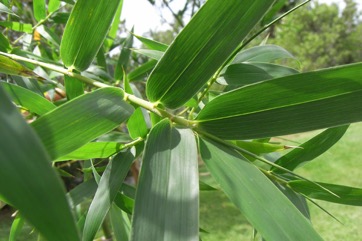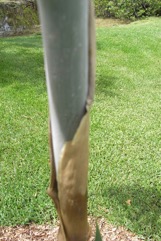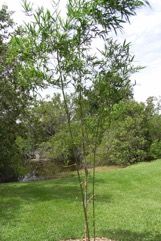Giant thorny bamboo, Spiny bamboo

A tropical plant. It grows in hot tropical climates. It is best in river valleys. It grows in mixed moist deciduous forest. AIt grows up to 1,000 m altitude.
Also known as:
Bambu berduri, Bambu duri, Bans, Baroowa, Behor, Biduru, Bonga-vedura, Chek sudo, Daba, Kalak, Kanta bans, Kantabanso, Karil, Kating, Kattaekalli, Kayalkkali, Ketua, Ketuasi, Ketwa, Kharra, Kotoba, Kotoha, Kya-kat-wa, Kyakat-wa, Moongil, Mulankumpu, Mulkas veduru, Mullu veduru, Naw mai phai paa, Nga-chat-wa, Phai-pa, Phaix pax, Pring ori, Russei khlei, Russei prei, Schee, Saneibi, Thorny bamboo, Tre gai rung, Tre laf ngaf
Synonyms
- See Bambusa arundinacea Arundo bambos L.
- Arundo arundinacea Retz.
- Bambusa arundinacea (Retz.) Willd.
- Bambusa spinosa Roxb.
Edible Portion
- Shoots, Seeds, Cereal
Where does Giant thorny bamboo grow?
Found in: Asia, Australia, Bangladesh, Cambodia, China, Himalayas, India, Indochina, Indonesia, Laos, Malaysia, Myanmar, NIcaragua, Northeastern India, Pacific, Pakistan, Philippines, SE Asia, Singapore, Sri Lanka, Thailand, Vietnam
Notes: There are about 120 Bambusa species. They are tropical and subtropical in Asia. Chemical composition: Seeds per 100 g edible portion. Water 8 g, Protein 13.5 g, carbohydrates 73 g, fibre 1 g, fat 0.4 g, ash 1.7 g, calcium 87 mg, P 163 mg. Shoots per 100 g edible portion. Water 87-88 g, protein 3.9-4.4 g, fat 0.5 g, carbohydrates 5.5 g, fibre 1 g, ash 1 g, Ca 20-24 mg, P 40-65 mg, Fe 0.1-0.4 mg Vit A 76 IU, Vit B1 0.16 mg, Vit B2 0.05 mg Vit C 0.3-0.5 mg The energy value is about 185 kJ/100g. Young shoots contain HCN so should be cooked.
Growing Giant thorny bamboo, Spiny bamboo
Cultivation: It can easily be grown from seed. It can be grown by cuttings of the rhizome or the stem. Fresh seed germinate in 5-10 days. Seeds can be stored for 6 months at cool temperatures and in dry condition. Seedlings are normally kept in a nursery for 2 years before planting out. When stem cuttings are used stems with 1-3 nodes are planted horizontally. They are treated with root promoting hormones. A spacing of 6 m is suitable.
Edible Uses: The shoots should be cooked to remove the bitter cyanide. The water should be changed. They are often pickled then eaten. The seeds are used for flour.
Production: A clump from seed reaches about 5 m high in 7 years. It achieves full growth of 25-50 stems in 20 years. A 1000 seeds weigh 11.6 g. Flowering occurs between 16-45 years.
Nutrition Info
per 100g edible portion| Edible Part | Energy (kcal) | Protein (g) | Iron (mg) | Vitamin A (ug) | Vitamin c (mg) | Zinc (mg) | % Water |
|---|---|---|---|---|---|---|---|
| Shoots | - | - | 0.1 | - | 5 | - | |
| Seeds | - | - | - | - | - | - |
Giant thorny bamboo, Spiny bamboo Photos



References
Arora, R. K., 2014, Diversity in Underutilized Plant Species - An Asia-Pacific Perspective. Bioversity International. p 36 (As Bambusa spinosa)
Ashton, M. S., et al 1997, A Field Guide to the Common Trees and Shrubs of Sri Lanka. WHT Publications Ltd. p 71
Bhatt, B. P., et al, 2003, Commercial edible bamboo species and their market potentiality in three Indian tribal states of the North Eastern Himalayan Region. J. Bamboo and Rattan. 2(2): 111-133
Cengel, D. J. & Dany, C., (Eds), 2016, Integrating Forest Biodiversity Resource Management and Sustainable Community Livelihood Development in the Preah Vihear Protected Forest. International Tropical Timber Organization p 125
Cruz-Garcia, G. S., & Price, L. L., 2011, Ethnobotanical investigation of 'wild' food plants used by rice farmers in Kalasin, Northeast Thailand. Journal of Ethnobiology and Ethnomedicine 7:33
Dransfield, S. & Widjaja, EA., 1995, Plant Resources of South East Asia. PROSEA No. 7 Bamboos. Leiden. p 56
Hibbert, M., 2002, The Aussie Plant Finder 2002, Florilegium. p 37
Kar, A., 2004, Common wild vegetables of Aka tribe of Arunachal Pradesh. Indian Journal of Traditional Knowledge 3(3) pp 305-313 (As Bambusa spinosa)
Kar, A., & Borthakur, S. K., 2007, Wild vegetables sold in local markets of Karbi Anglong, Assam. Indian Journal of Traditional Knowledge. 6(1) January 2007, pp169-172 (As Bambusa spinosa)
Marandi, R. R. & Britto, S. J., 2015, Medicinal Properties of Edible Weeds of Crop Fields and Wild plants Eaten by Oraon Tribals of Latehar District, Jharkhand. International Journal of Life Science and Pharma Research. Vo. 5. (2) April 2015
Martin, F.W. & Ruberte, R.M., 1979, Edible Leaves of the Tropics. Antillian College Press, Mayaguez, Puerto Rico. p 194
Misra S. & Misra M., 2016, Ethnobotanical and Nutritional Evaluation of Some Edible Fruit Plants of Southern Odisha, India. International Journal of Advances in Agricultural Science and Technology, Vol.3 Issue.1, March- 2016, pg. 1-30
Narayanan Ratheesh, M. K. et al, 2011, Wild edible plants used by the Kattunaikka, Paniya and Kuruma tribes of Wayanad District, Kerala, India. Journal of Medicinal Plants Research Vol. 5(15), pp. 3520-3529
Ochse, J.J. et al, 1931, Vegetables of the Dutch East Indies. Asher reprint. p 303
Pradhan, R., et al, 2020, Potential Wild Edible Plants and its Significance in Livelihood of Indigenous People of Male Mahadeshwara Hills, Karnataka. Economic Affairs Vol. 64, No. 4 pp. 01-14
Ray, A., et al, 2020, How many Wild Edible Plants do we Use. Frontiers in Sustainable Food Systems. 4:56 p 12
Sahni, K.C., 2000, The Book of Indian Trees. Bombay Natural History Society. Oxford. p 186
Singh, H.B., Arora R.K.,1978, Wild edible Plants of India. Indian Council of Agricultural Research, New Delhi. p 84
Sukarya, D. G., (Ed.) 2013, 3,500 Plant Species of the Botanic Gardens of Indonesia. LIPI p 836
Tanaka, Y. & Van Ke, N., 2007, Edible Wild Plants of Vietnam. Orchid Press. p 115
Teron, R. & Borthakur, S. K., 2016, Edible Medicines: An Exploration of Medicinal Plants in Dietary Practices of Karbi Tribal Population of Assam, Northeast India. In Mondal, N. & Sen, J.(Ed.) Nutrition and Health among tribal populations of India. p 154 (As Bambusa spinosa)
Terra, G.J.A., 1973, Tropical Vegetables. Communication 54e Royal Tropical Institute, Amsterdam, p 27
USDA, ARS, National Genetic Resources Program. Germplasm Resources Information Network - (GRIN). [Online Database] National Germplasm Resources Laboratory, Beltsville, Maryland. Available: www.ars-grin.gov/cgi-bin/npgs/html/econ.pl (10 April 2000)
Vartak, V.D. and Kulkarni, D.K., 1987, Monsoon wild leafy vegetables from hilly regions of Pune and neighbouring districts, Maharashtra state. J. Econ. Tax. Bot. Vol. 11 No. 2 pp 331-335
Vilm. Blumengaurtn. ed. 3, 1:1189. 1895
Wild edible plants of Himachal Pradesh (As Bambusa spinosa)
World Checklist of Useful Plant Species 2020. Royal Botanic Gardens, Kew (Also as Bambusa spinosa)